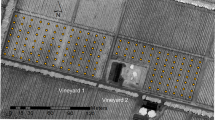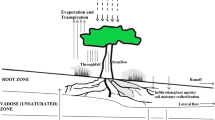Abstract
Sprinkler irrigation efficiency declines when applied water intercepted by the crop foliage, or gross interception (Igross), as well as airborne droplets and ponded water at the soil surface evaporate before use by the crop. However, evaporation of applied water can also supply some of the atmospheric demands usually met by plant transpiration. Any suppression of crop transpiration from the irrigated area as compared to a non-irrigated area can be subtracted from Igross irrigation application losses for a reduced, or net, interception (Inet) loss. This study was conducted to determine the extent in which transpiration suppression due to microclimatic modification resulting from evaporation of plant-intercepted water and/or of applied water can reduce total sprinkler irrigation application losses of impact sprinkler and low energy precision application (LEPA) irrigation systems. Fully irrigated corn (Zea Mays L.) was grown on 0.75 m wide east-west rows in 1990 at Bushland, TX in two contiguous 5-ha fields, each containing a weighing lysimeter and micrometeorological instrumentation. Transpiration (Tr) was measured using heat balance sap flow gauges. During and following an impact sprinkler irrigation, within-canopy vapor pressure deficit and canopy temperature declined sharply due to canopyintercepted water and microclimatic modification from evaporation. For an average day time impact irrigation application of 21 mm, estimated average Igross loss was 10.7%, but the resulting suppression of measured Tr by 50% or more during the irrigation reduced Igross loss by 3.9%. On days of high solar radiation, continued transpiration suppression following the irrigation reduced Igross loss an additional 1.2%. Further 4–6% reductions in Igross losses were predicted when aerodynamic and canopy resistances were considered. Irrigation water applied only at the soil surface by LEPA irrigation had little effect on the microclimate within the canopy and consequently on Tr or ET, or irrigation application efficiency.
Similar content being viewed by others
References
Baker JM, Van Bavel CHM (1987) Measurement of the mass flow of water in the stems of herbaceous plants. Plant Cell Environ 10:777
Frost KR (1963) Factors affecting evapotranspiration losses during sprinkling. Trans ASAE 6:282
Ham JM, Heilman JL, Lascano RJ (1990) Determination of soil water evaporation and transpiration from energy balance and stem flow measurements. Agric For Meteorol 52:287
Hansen VE (1960) New concepts in irrigation efficiency. Trans ASAE 3:55
Hatfield JL, Reginato RJ, Idso SB (1984) Evaluation of canopy temperature-evapotranspiration models over various crops. Agric Meteorol 32:41
Lourence FJ, Pruitt WO (1969) A psychrometer system for micrometeorology profile determination. J Appl Meteorol 8:492
Lyle WM, Bordovsky JP (1981) Low energy precision application (LEPA) irrigation system. Trans ASAE 24:1241
Lyle WM, Bordovsky JP (1983) LEPA irrigation system evaluation. Trans ASAE 26:776
Marek TH, Schneider AD, Howell TA, Ebeling LL (1988) Design and construction of large weighing monolithic lysimeters. ASAE Paper 86–2525. ASAE, St. Joseph, WI
McMillan WD, Burgy RH (1960) Interception loss from grass. J Geophys Res 65:2389
McNaughton KG (1981) Net interception losses during sprinkler irrigation. Agric Meteorol 24:11
Monteith JL (1963) Gas exchange in plant communities. In: Evans LT (ed) Environmental control of plant growth. Academic Press, New York, p 95
Monteith JL (1965) Evaporation and environment. In: The state and movement of water in living organisms. XIXth Symposium Soc Exp Biol, Academic Press, New York, p 205
Monteith JL (1973) Principles of environmental physics. Edward Arnold, London
Norman JM, Campbell G (1983) Application of a plant-environment model to problems in irrigation. In: Hillel D (ed) Advances in irrigation, Vol 2. Academic Press, New York, p 155
Robinson FE (1970) Modifying an arid microclimate with sprinklers. Agric Eng 51:465
Rutter AJ (1975) The hydrological cycle in vegetation. In: Monteith JL (ed) Vegetation and the atmosphere, Vol 2. Academic Press, London, p 111
Schneider AD, Howell TA (1990) Sprinkler efficiency measurement with large weighing lysimeters. In: Visions of the future: Proceedings of the third national irrigation symposium, October 28–November 1, 1990, Phoenix, AZ, ASAE, St. Joseph, MO, p 69
Seginer I (1967) Net losses in sprinkler irrigation. Agric Meteorol 4:281
Steiner JL, Kanemasu ET, Clark RN (1983a) Spray losses and partitioning of water under a center pivot sprinkler system. Trans ASAE 26:1128
Steiner JL, Kanemasu ET, Hasza D (1983b) Microclimatic and crop responses to center pivot sprinkler and to surface irrigation. Irrig Sci 4:201
Stoltenberg NL, Wilson TV (1950) Interception storage of rainfall by corn plants. Am Geo Union Trans 31:443
Szeicz G, Van Bavel CHM, Takami S (1973) Stomatal factor in the water use and dry matter production by sorghum. Agric Meteorol 12:361
Thom AS (1975) Momentum, mass, and heat exchange of plant communities. In: Monteith JL (ed) Vegetation and the atmosphere, Vol 2. Academic Press, New York, p 57
Thompson AL, Gilley JR, Norman JM (1993) A sprinkler droplet evaporation and plant canopy model. II. Model application. Trans ASAE 36:743
Waggoner PE, Begg JE, Turner NC (1969) Evaporation of dew. Agric Meteorol 6:227
Author information
Authors and Affiliations
Rights and permissions
About this article
Cite this article
Tolk, J.A., Howell, T.A., Steiner, J.L. et al. Role of transpiration suppression by evaporation of intercepted water in improving irrigation efficiency. Irrig Sci 16, 89–95 (1995). https://doi.org/10.1007/BF00189165
Received:
Issue Date:
DOI: https://doi.org/10.1007/BF00189165




